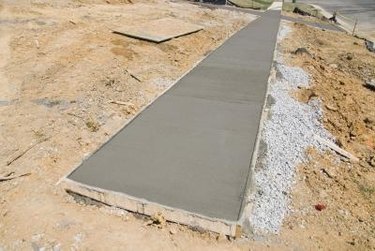
Lime has been used in construction for thousands of years, and can be used as a strong, durable mortar that enhances the home and reduces environmental impact. However, cement may be needed for situations where curing time is of the essence. Concrete applications often include both cement and lime in order to take advantage of the special properties of each.
Chemical Composition
Video of the Day
Lime is produced from natural limestone by burning the stone in a kiln until only quicklime -- calcium oxide -- is left behind. The quicklime is then mixed with small amounts of water to create hydrated lime, which may be included in cement or mixed with water for use as mortar. Lime hardens by slowly absorbing carbon dioxide and turning back to limestone over time. Cement consists of highly reactive silica-containing compounds -- when mixed with water, they harden quickly.
Video of the Day
Physical Properties
Lime hardens much more slowly than cement-containing mortars, making it much more workable. Lime is also less brittle and less prone to cracking, and any cracked areas can absorb carbon dioxide and mend over time. Cement hardens very quickly, but may be too strong for some applications, e.g., working with old bricks. Cement is also prone to cracking as a structure settles, and may eventually require repair.
Vapor Barrier
Lime is also breathable, allowing vapors to pass through, which can reduce moisture and improve the environment of the home. Cement creates a waterproof barrier that does not allow vapors to escape, and can absorb water, causing moisture to accumulate -- especially in basements.
Environmental Concerns
Lime production results in release of carbon dioxide into the atmosphere, but lime mortar absorbs carbon dioxide from the atmosphere over its lifetime. As a result, lime mortar is considered by environmentalists to be "carbon neutral." In contrast, cement production contributes greatly to global warming, as copious amounts of carbon dioxide are released during its production.